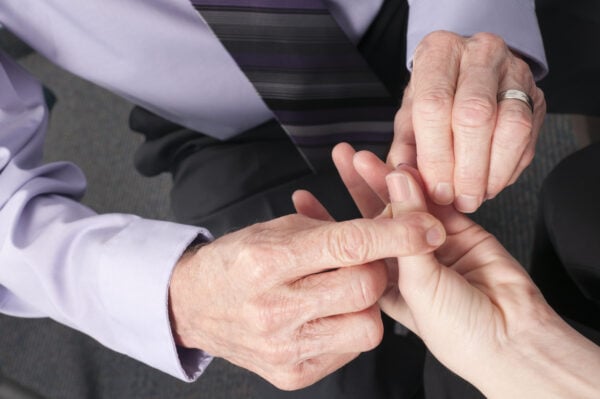CARPAL TUNNEL SYNDROME
The carpal tunnel is a narrow compartment within your wrist that’s made up of bones and the carpal ligament. Passing through this tunnel are nine tendons and the median nerve (one of the main nerves in your arm). When the tunnel gets smaller, there’s less space for the median nerve. It then becomes “entrapped,” or compressed, leading to numbness, tingling, reduced dexterity, and sometimes weakness in the affected hand.

But just because it’s so common doesn’t mean you have to live with it. There are treatment options to help you get back to doing what you love without carpal tunnel syndrome getting in the way.
WHAT IS CARPAL TUNNEL SYNDROME?
Carpal tunnel syndrome (CTS) is a condition that occurs when the median nerve running from the forearm into the palm of the hand becomes compressed at the wrist, leading to numbness, tingling, weakness, and pain in the wrist.
The dominant hand is typically affected first and most severely. Some people may feel more intense symptoms during particular activities, such as driving, typing on a keyboard, or talking on the phone. And many sufferers report that their pain is worse at night.
WHAT ARE SYMPTOMS OF CARPAL TUNNEL SYNDROME?
The most common symptoms of CTS include:
- Hand weakness
- Pain in the hand, wrist, or forearm
- Numbness or tingling in the hand or fingers
- Impaired dexterity, resulting in dropping objects
CTS symptoms can make it difficult to perform computer work or other daily tasks and can even hinder your ability to grip objects. If left untreated, CTS can worsen over time.
WHAT CAUSES CARPAL TUNNEL SYNDROME?
It’s often hard to pinpoint the exact cause of carpal tunnel syndrome. It can sometimes result from a combination of factors. Anything that creates pressure on the median nerve and tendons in the carpal tunnel can potentially lead to CTS.
Injury to the wrist, thickening of the tendons, or a cyst in the carpal tunnel could lead to CTA.
WHO IS AT RISK FOR CARPAL TUNNEL SYNDROME?
Statistically, women are three times more likely to have CTS than men. Some other common risk factors include:
- Trauma or injury
- Rheumatoid arthritis
- Smaller carpal tunnel
- High blood pressure
- Pregnancy
- Diabetes
- Pituitary or thyroid gland issues
There’s a combination of genetic and environmental factors that can contribute to CTS. Your work environment can also play a major role. If your occupation requires using your hands and wrists in a repetitive motion, such as computer work, sewing, or manufacturing, you could be at increased risk for CTS.
HOW CAN CARPAL TUNNEL SYNDROME BE TREATED?
If you’re experiencing signs of carpal tunnel syndrome, don’t wait to take action. CTS can worsen over time and potentially lead to permanent median nerve damage.
Fortunately, there are ways to treat CTS. At OC Wellness Physicians Medical Group, we create a comprehensive, individualized treatment plan for your carpal tunnel syndrome. We utilize various modalities, including:
- Chiropractic Care — focuses on alignment of your neck and spine, which play a role in CTS symptoms. Gentle yet precise manipulation of your wrist and arms help to alleviate pain.
- Physical Therapy — helps increase mobility in your hands and wrists, while strengthening muscles in the surrounding areas.
- Massage Therapy — massaging the muscles and fascia in your neck, shoulders, arms, wrists, and hands can help reduce inflammation, numbness, and pain in these areas and prevent future CTS occurrences.
- Acupuncture — this healing modality helps relieve painful symptoms, aid nerve repair, and improve sensory and motor functions.
- Splints and Ergonomic Advice — since CTS can be caused or exacerbated by repetitive motion and improper alignment, it’s essential to use proper body mechanics to protect your wrist.
- Regenerative Medicine — this advanced, natural therapy may be the best option if you have permanent nerve or muscle damage.
Dealing with the persistent symptoms of CTS can be frustrating and overwhelming. Our goal is not only to alleviate your pain but to offer you compassion and support throughout your treatment process.
HOW CAN CARPAL TUNNEL SYNDROME BE PREVENTED?
Prevention is the best medicine. Try to keep your wrists and hands in a neutral alignment when working at the computer. Avoid small, repetitive motions for an extended period and take frequent breaks to stretch your hands and wrists.
WHAT CAN I EXPECT DURING MY FIRST VISIT?
If you’ve developed CTS symptoms, OC Wellness Physicians Medical Group offers treatments to relieve your pain, manage your symptoms, and help prevent future flare-ups.
After gathering your medical history and performing a physical examination of your arm, wrist, and hand, we may take x-rays or perform other tests to accurately diagnose the issue. We’ll then work with you to develop an optimal treatment plan for your unique situation.
At OC Wellness Physicians Medical Group, we’re committed to helping you feel your best each day. We’re here to help alleviate the discomfort from carpal tunnel syndrome and get you back to your daily activities without pain. Schedule a consultation today to get started on your path to healing!
